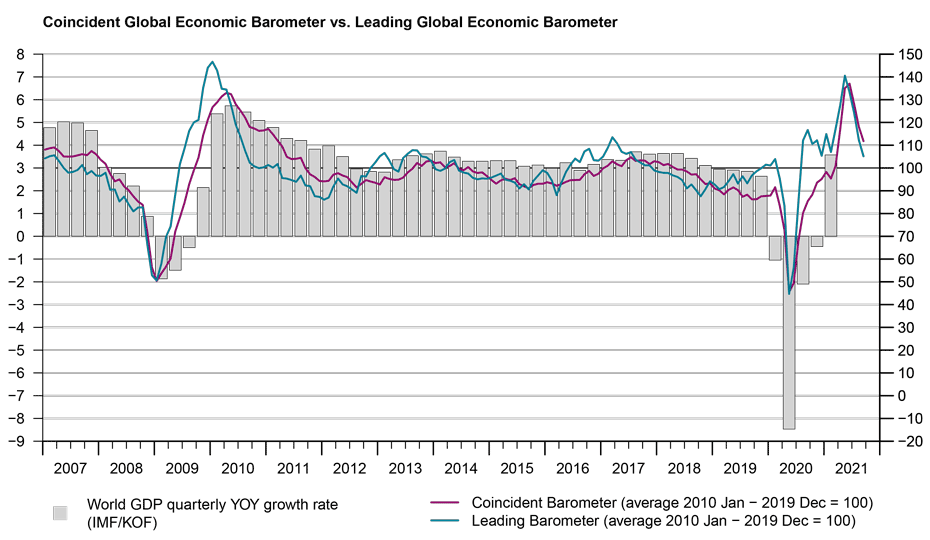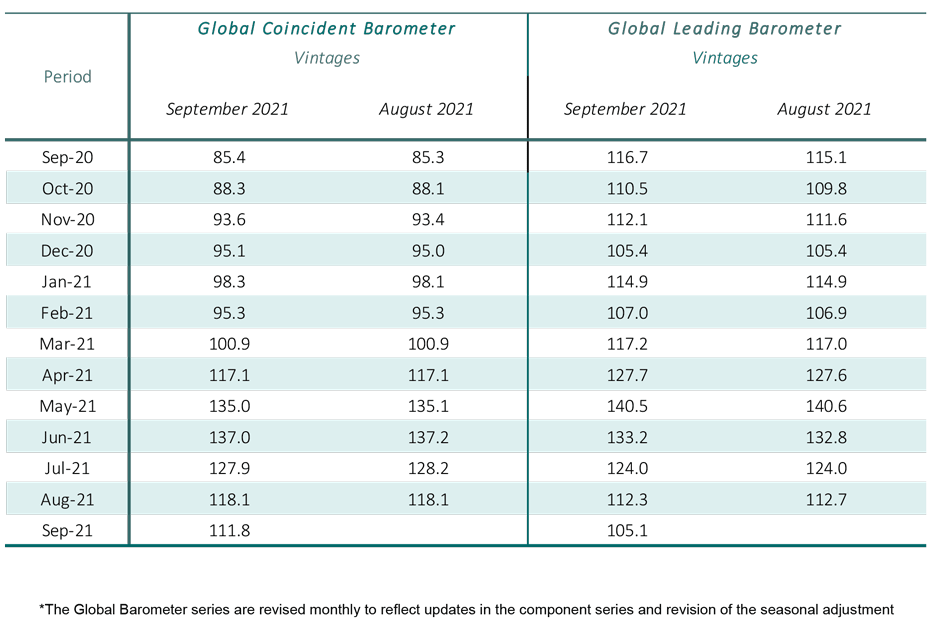Global Barometers signal slower economic growth for the second half of the year
In September, the Global Economic Barometers maintain their weakening tendency that started in July, reflecting the slowdown in world economic growth in the second half of 2021. Despite the fall, the indicator levels remain high and compatible with the continuity of the current phase of recovery of the world economy.
The Coincident Global Barometer decreases by 6.3 points in September to 111.8 points. The Leading Global Barometer falls 7.2 points, to 105.1 points. All the investigated regions developed negatively in September, with larger losses in the Asia, Pacific and Africa region for the Coincident Barometer and in Europe for the Leading Barometer.
“Despite ongoing vaccination campaigns, which remains the safest way out of the pandemic, the fourth wave of the pandemic and ongoing problems in supply chains are weighing on the global economic recovery. Although it was to be expected that economic growth cannot be maintained at the high level of fall 2020 and spring 2021 for long, the speed at which the barometers continue to move toward their long-term averages remains high”, comments KOF-Director Jan-Egbert Sturm.

Coincident Barometer – regions and sectors
The Asia, Pacific and Africa region contributes the most (-3.9 points) to the fall in the Coincident Global Barometer, followed by Europe and the Western Hemisphere, with negative contributions of 1.3 and 1.1 points, respectively. However, all regions continue to show indicators above the historical average of 100 points. The graph below illustrates the contribution of each region to the deviation of the Coincident Barometer from this long-run average.
All five of the studied sectors contribute negatively to the aggregate result of the Coincident Barometer in September. The indicator that measures the aggregated development of economies (Economy) make the strongest contribution to the fall this month, followed by Industry and Trade. The negative contributions of the other three sectors are somewhat more modest. The indicator for the Services sector decreases for the third consecutive month, albeit at a slower rate, and continues to record the highest level among the sectors.
Leading Barometer – regions and sectors
The Leading Global Barometer leads the world economic growth rate cycle by three to six months on average. The leading indicators of the three regions contribute negatively to the result of the Leading Barometer in September. Europe contributes -3.7 points to the fall, followed by the Asia, Pacific and Africa region with -2.3 points, and the Western Hemisphere with a negative contribution of 1.2 points. Europe, which was the most optimistic region last month, is now the only region, by recording 99.9 points, to have fallen back to its long-run average. The other two regions remain above this level.
All the Leading Barometer sectors decline in September, with the strongest contributions to the aggregate result coming from Industry and the indicator that measures the aggregated development of economies (Economy). The other sectors contribute modestly to the final result. With this month’s decrease, Economy records a level below 100 points for the first time since July 2020, while the Construction, Services, and Trade sectors continue to record levels that reflect an above-average growth outlook.

The Global Economic Barometers
The Global Economic Barometers are a system of indicators enabling timely analysis of global economic development. They represent a collaboration between the KOF Swiss Economic Institute of the ETH Zurich in Switzerland and Fundação Getulio Vargas (FGV), based in Rio de Janeiro, Brazil. The system consists of two composite indicators, the Coincident Barometer and the Leading Barometer. The Coincident Barometer reflects the current state of economic activity, while the Leading Barometer provides a cyclical signal roughly six months ahead of current economic developments.
The two Barometers comprise the results of economic tendency surveys conducted in more than 50 countries with the aim of achieving the broadest possible global coverage. The advantages of economic tendency surveys are that their results are usually readily available and are not substantially revised after first publication.
The Coincident Barometer includes more than 1,000 different time series, while the Leading Barometer consists of over 600 time series. Cross-correlation analysis is used to decide which individual time series are included in the barometers. This involves correlating the individual time series with a reference series. The reference series used is the year-on-year growth rate of global gross domestic product (GDP), where the individual national GDPs are aggregated at purchasing power parity to form global GDP. A time series is only included in a Barometer if it shows a sufficiently high correlation and a suitable synchronization or lead with the reference series. The time period used for this correlation analysis currently runs from January 2010 to December 2019.
The series of the two Barometers are revised each month at publication and are standardized to have a mean of 100 and a standard deviation of 10 for the 10-year period previous to the most recent observations.
The methodology is described in:
Klaus Abberger, Michael Graff, Aloisio Jr. Campelo, Anna Carolina Lemos Gouveia, Oliver Müller and Jan-Egbert Sturm (2020), The Global Economic Barometers: Composite indicators for the world economy. KOF Working Papers, vol. 471, Zurich: KOF Swiss Economic Institute, ETH Zurich, 2020.
The full press release with tables and graphs can be found Download here (PDF, 521 KB).
More information on the Global Economic Barometers can be found here.
Contact
KOF Konjunkturforschungsstelle
Leonhardstrasse 21
8092
Zürich
Switzerland